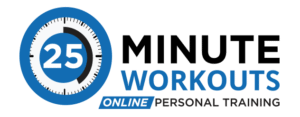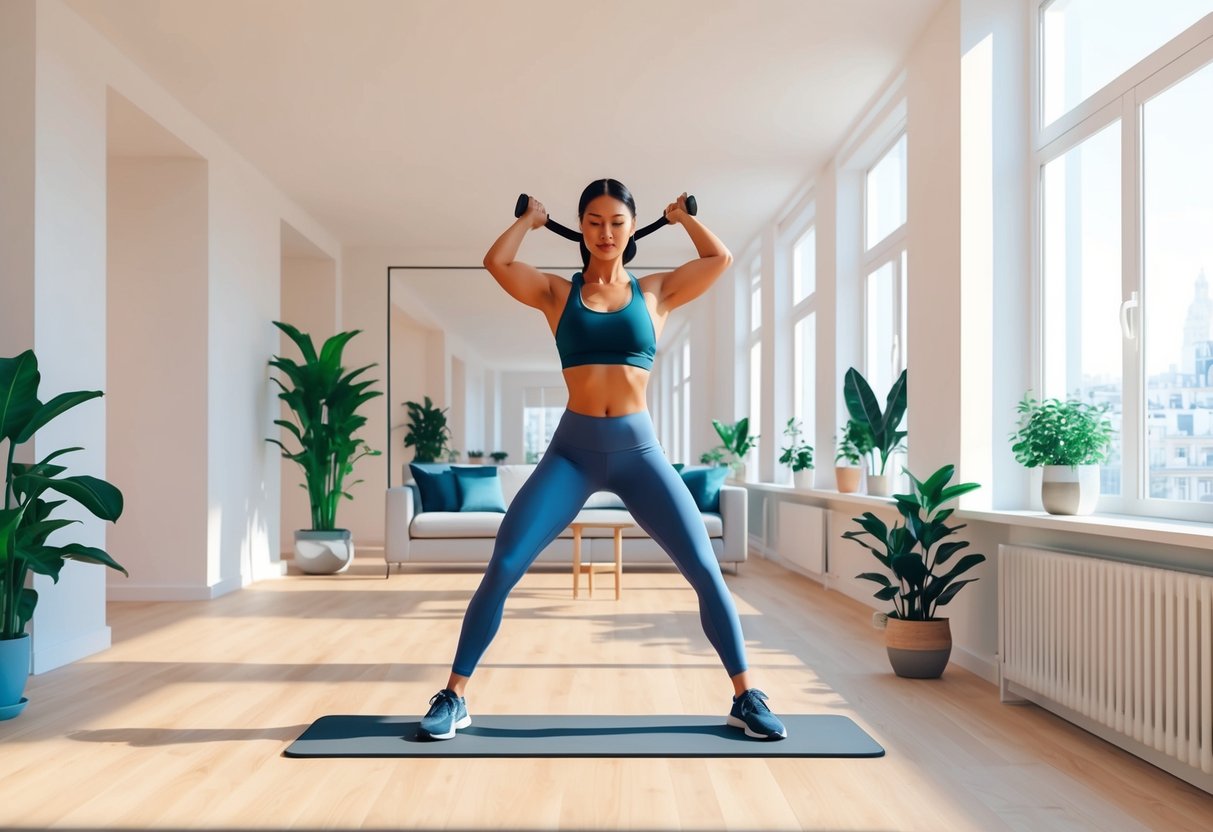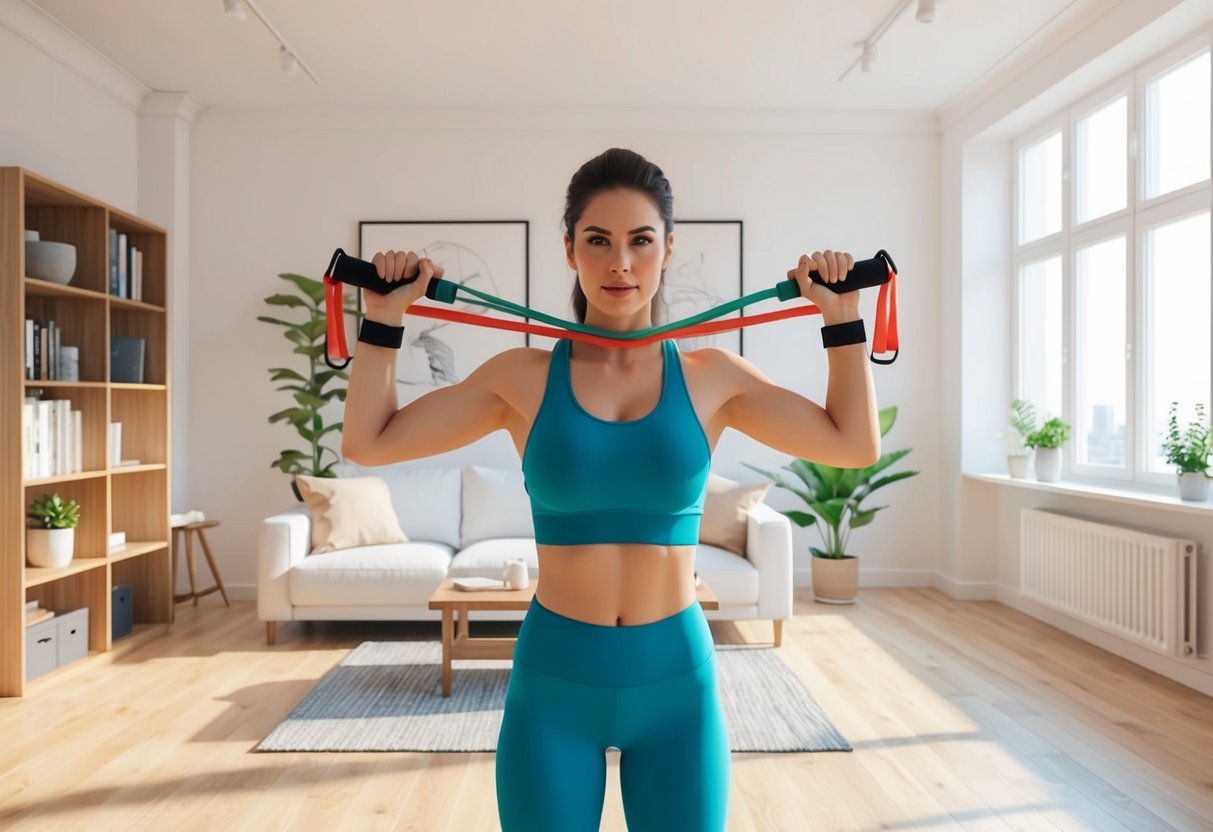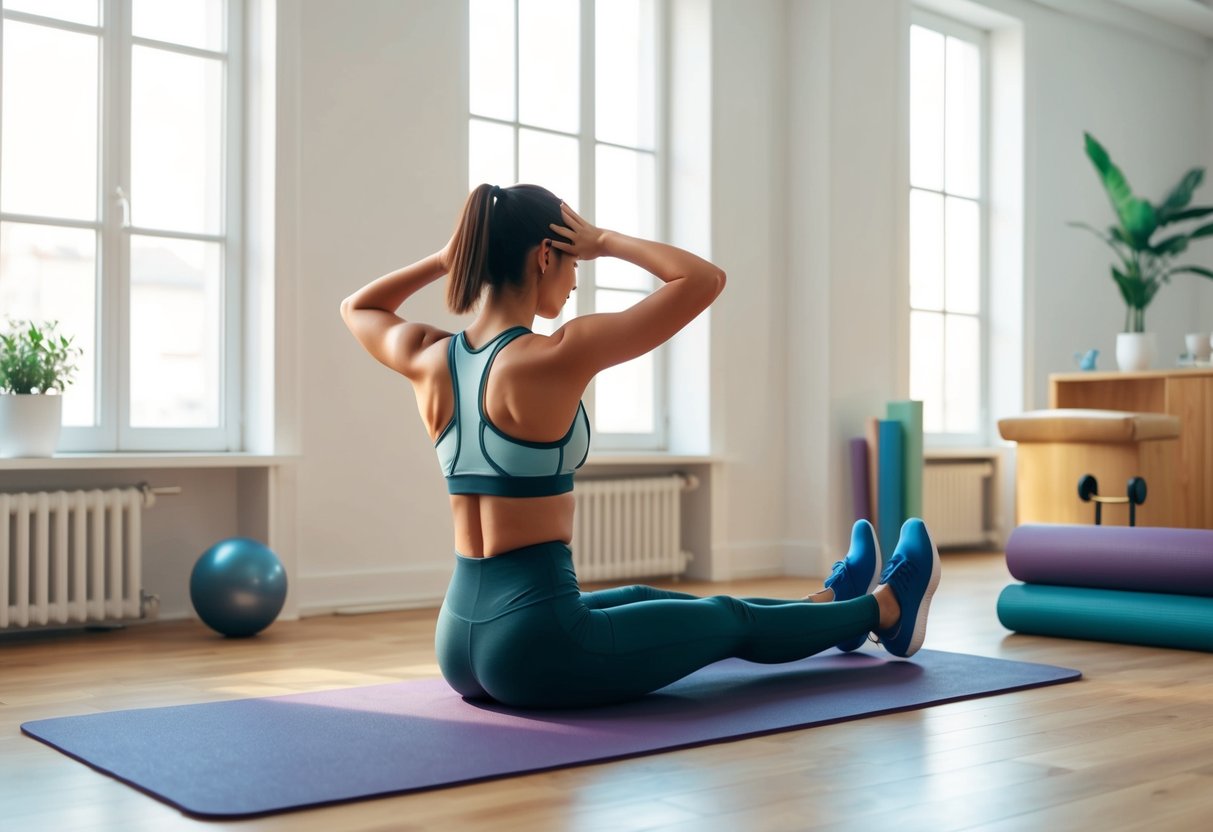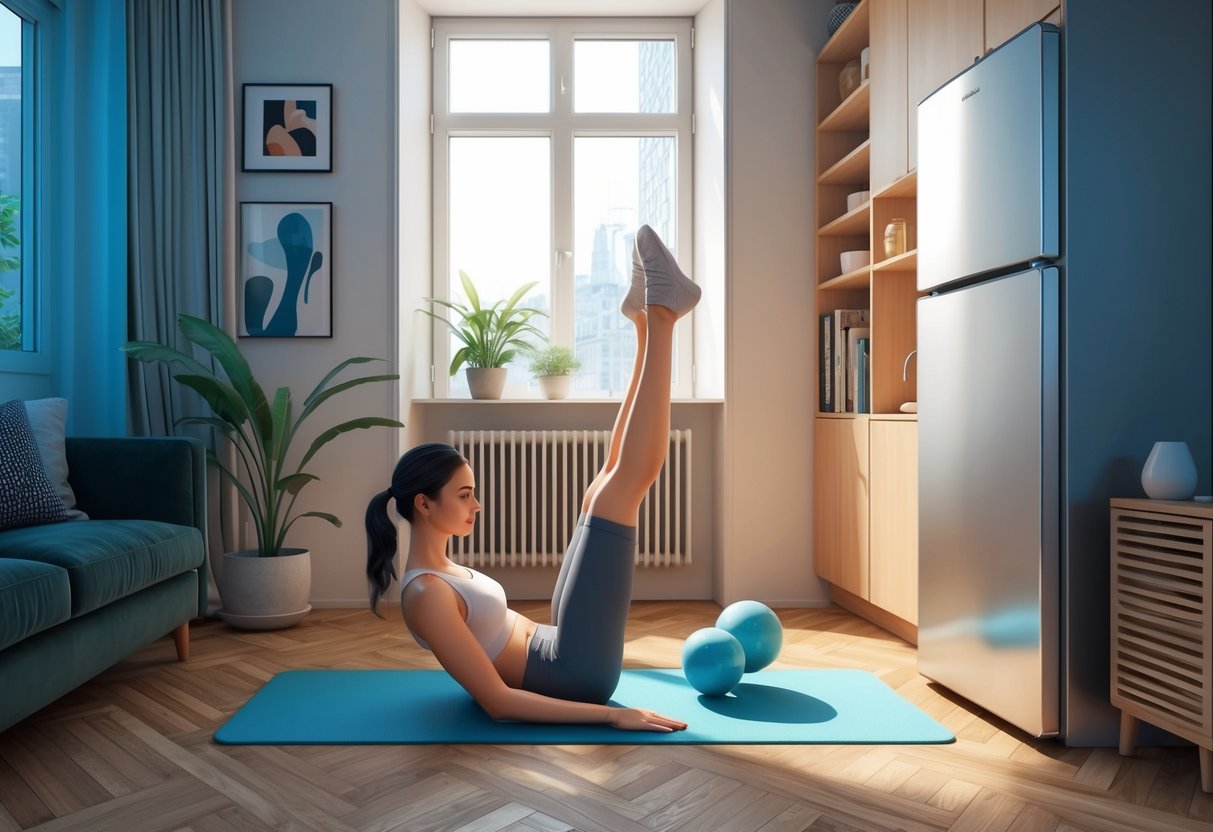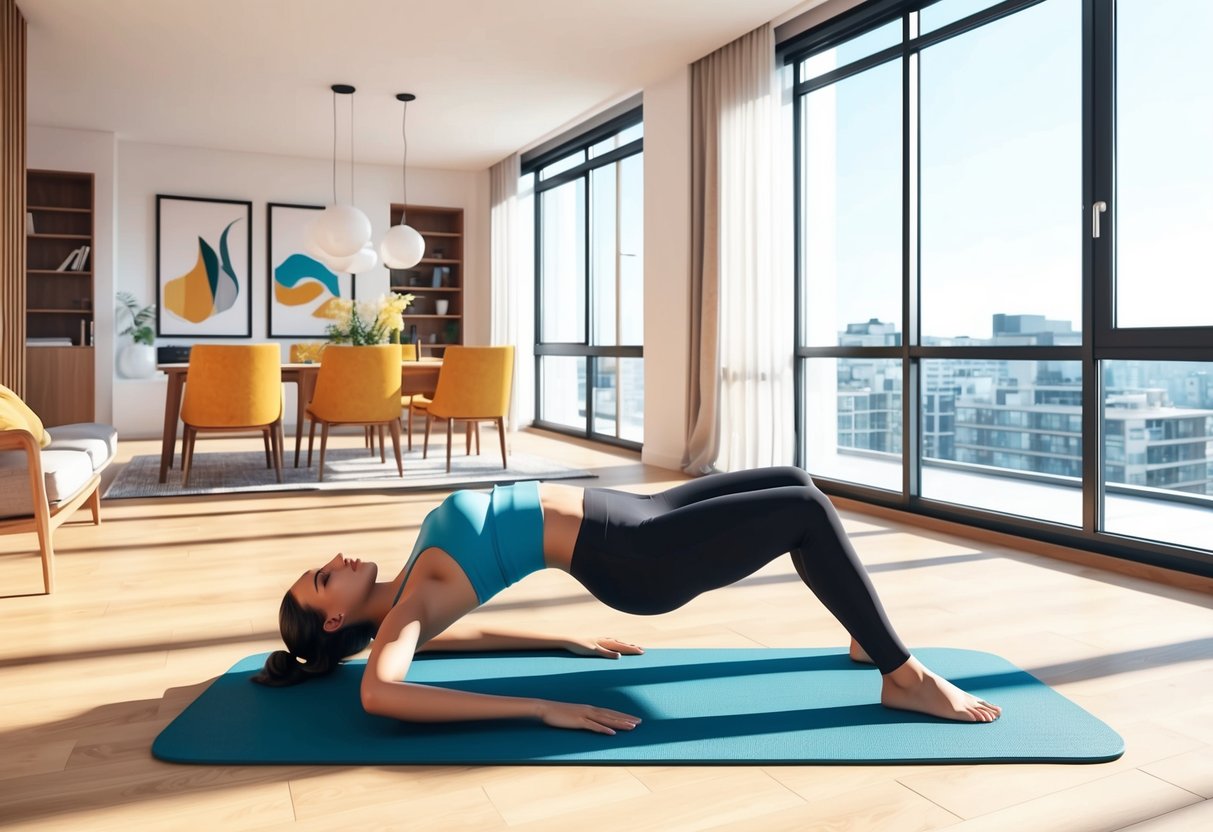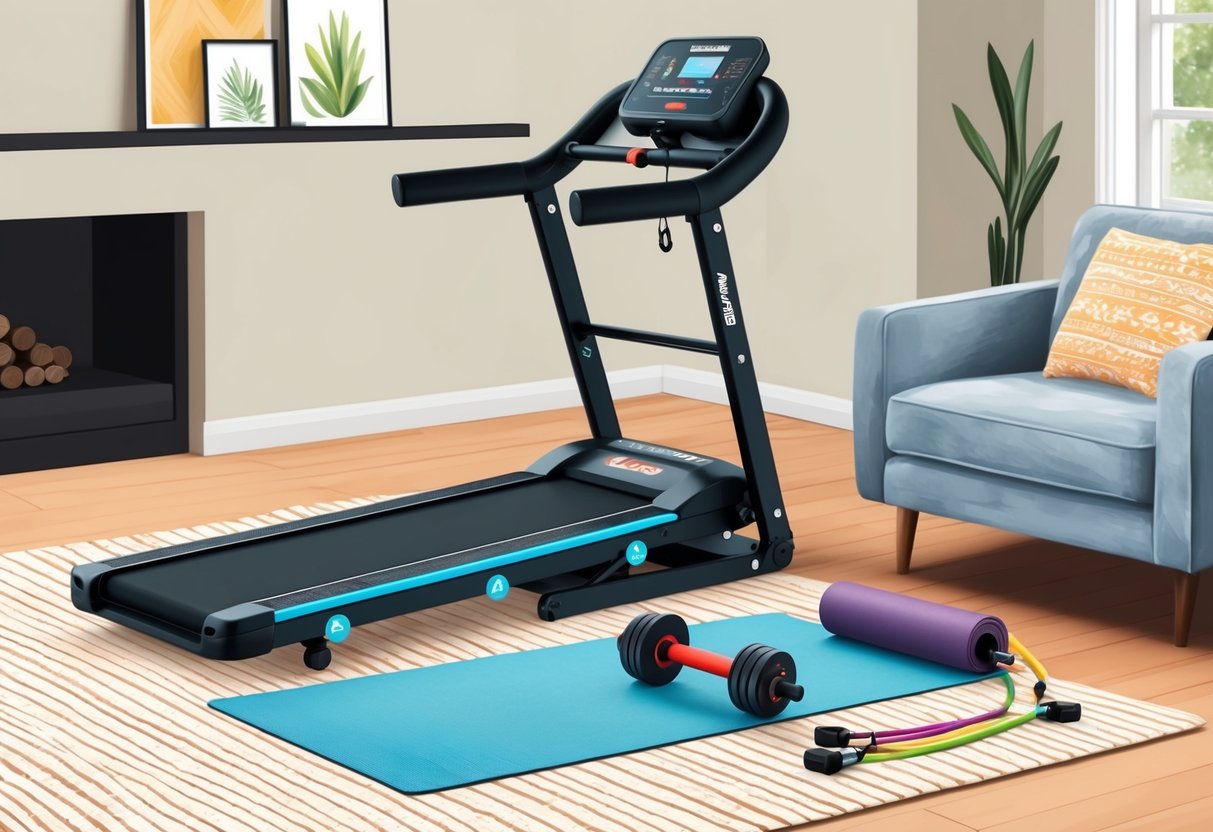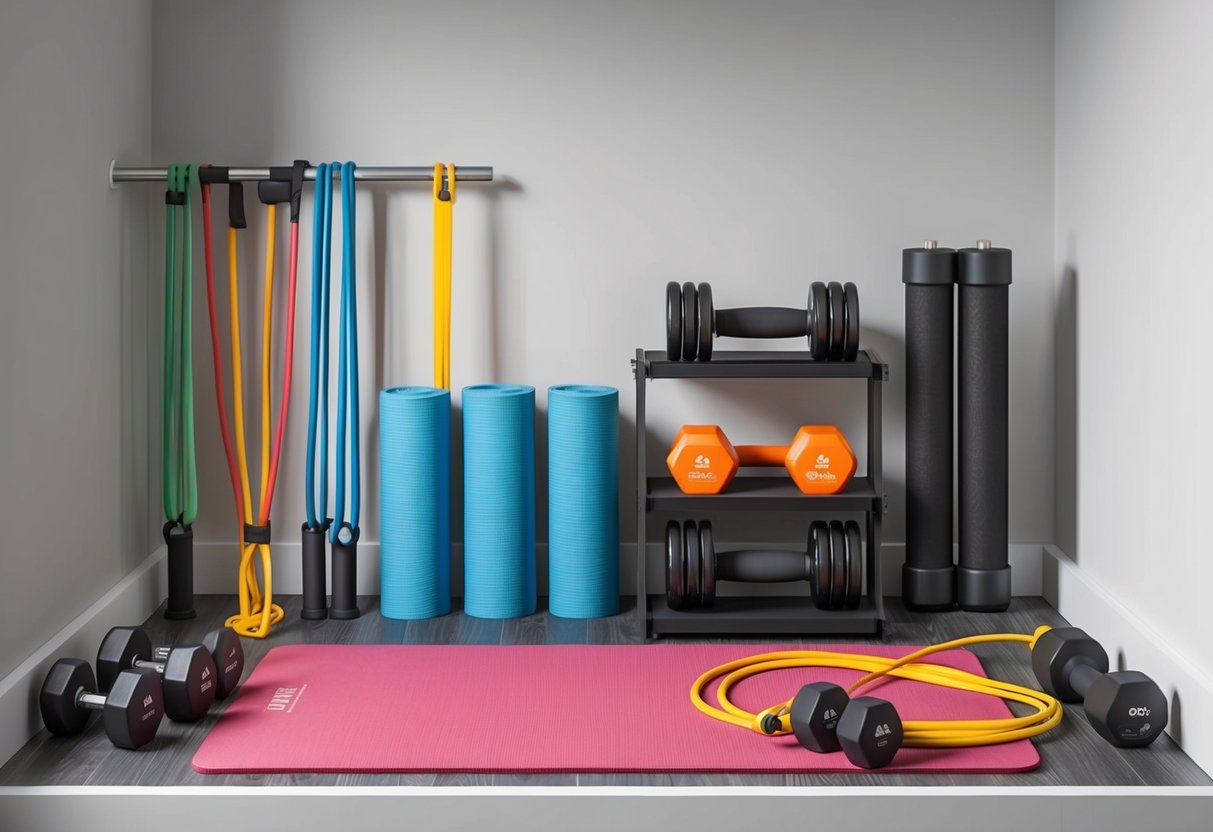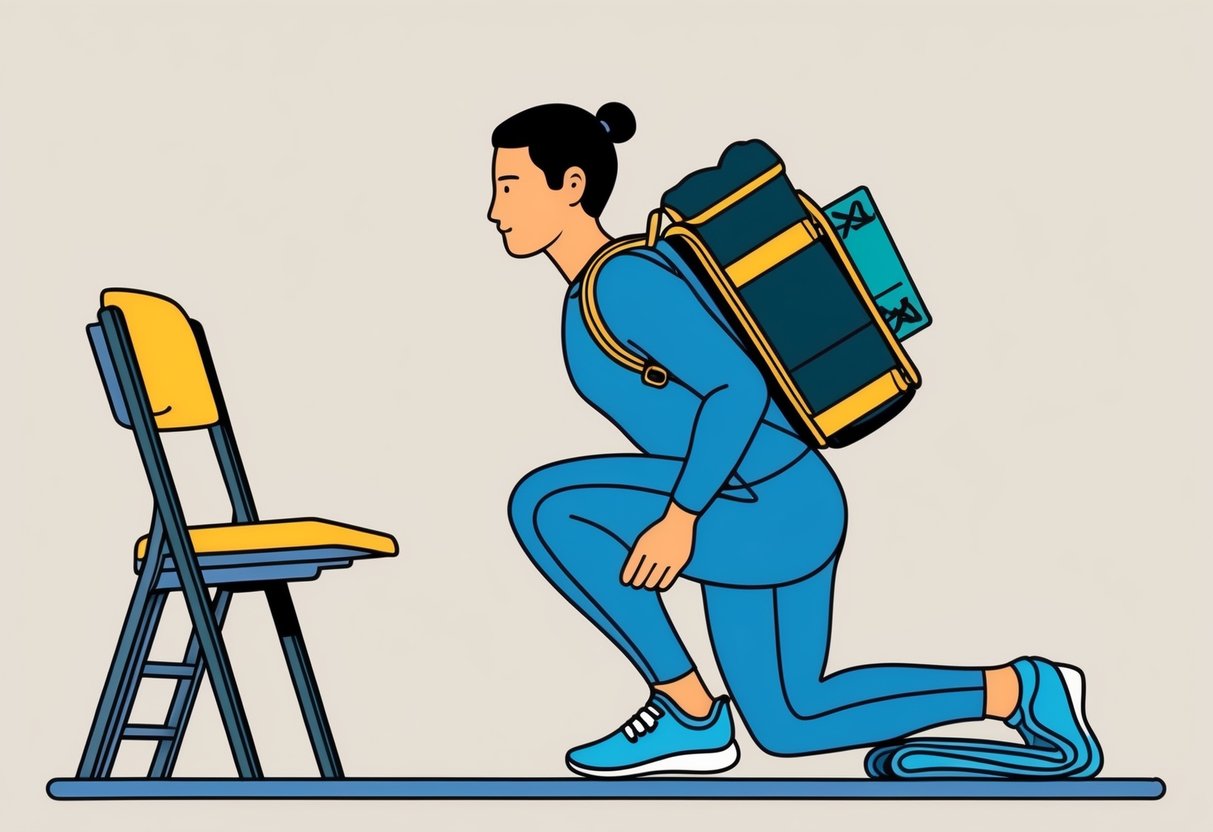Staying fit in a small apartment doesn’t have to be a challenge. You can achieve your fitness goals without leaving your rental space or disturbing your neighbors.
A consistent exercise routine is crucial for your overall health and well-being. Regular physical activity can significantly reduce your risk of various health issues and improve your quality of life.

This guide will introduce you to 17 apartment-friendly exercises that require minimal space and equipment. You’ll discover effective workouts that target different muscle groups, from arms and shoulders to legs and abs.
We’ll also explore the best compact exercise equipment for small spaces and provide clever storage solutions. Plus, you’ll learn about household items that can double as workout gear, saving you money and space.
Popular Posts
- Massage Gun vs. Foam Roller: Which Recovery Tool Reigns Supreme?
- 27 Best Calisthenics Exercises for Full-Body Strength and Fitness
- 10 HIIT Workouts for Busy Professionals: Max Fitness, Min Time
- Good Posture Working from Home: Optimize Your Workspace to Prevent Discomfort and Health Issues
- The Best Crossfit Exercises for Full-Body Conditioning
Key Takeaways
- Regular apartment workouts can improve your health and fitness without disrupting neighbors
- Effective exercises for small spaces target all major muscle groups using minimal equipment
- Creative storage solutions and household item alternatives make apartment fitness accessible
2. Building Strong Arms

Bicep Curls
Bicep curls are essential for developing your upper arm strength.
Start by standing with weights in each hand, arms at your sides. Lift one weight at a time, bending your elbow to bring the weight toward your shoulder. Keep your back straight and eyes forward.
You can perform these seated or standing, with weights parallel or perpendicular to your body.
For a challenge, try curling both arms simultaneously while standing. Hold the weights end-to-end and lift them together in one fluid motion.
No weights? No problem. Grab water jugs or food cans as substitutes.
Targeting Triceps
Tricep extensions effectively work the back of your upper arms.
You can do these sitting or standing with slightly bent knees. Hold a weight above your head, forming a triangle with your hands at its base. Position your arms near your ears with elbows pointing forward. Lower the weight behind your head, keeping elbows close to your ears, then lift back up.
Want to increase the intensity? Try single-arm extensions.
If you lack weights, a jug of water or laundry detergent bottle works well.
Bodyweight Dips
Dips strengthen your triceps, chest, and front shoulder muscles.
Find a sturdy chair or couch (ensure it’s against a wall if it has wheels). Sit on the edge with legs extended, heels on the floor. Grip the edge of the seat and lower your body until your elbows form right angles. Push back up to complete one rep.
To make it harder, position your hands closer together. This targets your triceps more intensely.
Remember, safety first. Use a stable surface that can support your weight.
2. Building Stronger Shoulders
Elevating Your Traps
Shoulder elevation exercises are excellent for strengthening the trapezius muscles. These muscles play a crucial role in supporting your neck, upper back, and shoulders.
Start by standing with your feet shoulder-width apart. Grasp a dumbbell in each hand, letting your arms hang naturally at your sides. Slowly raise your shoulders towards your ears, hold for a moment, then lower them back down. Repeat this motion for 10-15 repetitions.
For added challenge, try performing this exercise while seated on the edge of a chair or bench. This variation engages your core muscles more intensely.
If you lack proper equipment, substitute dumbbells with filled water bottles or books of similar weight. Remember to maintain proper form throughout the exercise to maximize its benefits and minimize the risk of injury.
Pressing Overhead
The overhead press is a powerful exercise that targets your deltoids and triceps. You can perform this movement using dumbbells, a barbell, or resistance bands.
Begin by holding a dumbbell in each hand at shoulder height. Your palms should face forward, and your elbows should be bent at roughly 90 degrees. Push the weights directly upward until your arms are fully extended overhead. Slowly lower the weights back to the starting position.
You can execute this exercise either standing or seated. The standing variation engages your core and back muscles more intensively, providing a fuller body workout.
To increase the difficulty, try performing the exercise on one leg at a time. This modification challenges your balance and further activates your stabilizing muscles.
For those without access to gym equipment, canned goods or filled water bottles can serve as suitable replacements for dumbbells. Aim for objects weighing between 1-2 pounds for beginners, gradually increasing as you build strength.
3. Build Your Chest Muscles
Pushups
Pushups are a classic exercise that targets your chest while also engaging your shoulders, triceps, and abs.
Start by lying face-down on the floor. Place your hands slightly wider than shoulder-width apart. Lift your body, supporting yourself on your hands and toes. Keep your back straight and core engaged.
Lower your chest toward the floor, then push back up. Aim to keep your elbows close to your body as you move.
For beginners, try doing pushups with your knees on the ground. As you gain strength, progress to full pushups.
To increase the challenge, try diamond pushups by forming a diamond shape with your hands, or widen your hand placement for a greater chest focus.
Pushups are versatile and can be done anywhere. A carpeted area or yoga mat can provide extra comfort for your hands and knees.
Dumbbell Floor Press
The dumbbell floor press is an excellent chest and tricep exercise, especially if you have shoulder concerns. It focuses on your chest muscles without putting excessive strain on your shoulders.
Begin by sitting on the floor with a dumbbell on each side. Place the weights on your thighs, then carefully lie back while holding them. Position your arms at a 45-degree angle to your body, with your triceps touching the floor. Your knees should be bent, feet flat on the ground.
Grip the dumbbells firmly, turning them slightly inward. Push the weights up until they meet above your chest, then lower them back down. Keep your movements controlled throughout the exercise.
To make this exercise more challenging, try extending your legs out straight. This reduces your stability and engages your core more.
If you don’t have dumbbells, you can use household items like filled water bottles or books as weights. Just be sure they’re secure and won’t slip from your grasp.
4. Strengthening Your Back
Superman Pose
Lie face down on a soft surface. Extend your arms forward and legs backward. Lift your limbs, chest, and head simultaneously. Balance on your midsection for 1-3 seconds. Lower and repeat.
For added challenge, raise opposite arm and leg. Use a book for extra resistance.
Rear Deltoid Lifts
Stand with feet shoulder-width apart. Grasp weights in each hand. Bend forward at the hips, keeping your back straight. Raise arms out to the sides until level with your back. Squeeze shoulder blades together. Lower slowly.
Try this seated to focus on rear deltoids. Books can substitute for weights.
One-Arm Weight Pull
Step one foot back in a lunge position. Lean forward, resting one hand on your front thigh. Hold a weight in your free hand. Pull it up towards your ribs, squeezing your shoulder blade. Lower slowly.
Perform this on a sofa edge for increased difficulty. Filled jugs work well as weight alternatives.
5. Exercises for Your Legs
Squats
Squats are a cornerstone of leg workouts, targeting multiple muscle groups simultaneously.
Start with your feet shoulder-width apart, toes slightly outward. Lower your body until your thighs are parallel to the floor, forming a 90-degree angle behind your knees. Push back up, driving your feet into the ground.
Maintain proper form by keeping your knees from extending past your toes.
To challenge yourself, hold dumbbells or use a weighted barbell. A backpack filled with books can serve as a makeshift weight if you’re exercising at home.
Split Squats for Balance
This variation of the squat focuses on your quads and improves balance.
Stand in front of a chair or sofa, placing one foot behind you on the elevated surface. Lower your body until your front thigh is parallel to the ground, keeping your back knee close to, but not touching, the floor. Ensure your front knee remains stable throughout the movement.
Increase the intensity by holding weights or a loaded backpack. This exercise strengthens your legs while enhancing your overall stability.
Raising Your Calves
Calf raises are simple yet effective for building lower leg strength.
Stand in a doorway for balance, then rise up on your toes, lifting your heels off the ground. Hold the top position briefly before lowering back down.
Focus on using only your calf muscles to power the movement.
For an added challenge, perform this exercise on a step or while holding weights. Remember to stretch your calves before and after to prevent tightness.
Bridges for Your Glutes
Glute bridges target your buttocks, hamstrings, and lower back.
Lie on your back with your knees bent and feet flat on the floor.
Lift your hips until your body forms a straight line from knees to shoulders.
Engage your core throughout the movement for stability.
To make this exercise more challenging, try performing it with one leg raised.
You can also elevate your feet on a step or sturdy object to increase the range of motion.
These exercises form a solid foundation for strengthening your legs.
They require minimal equipment and can be easily adapted to suit your fitness level.
Regular practice will improve your leg strength, benefiting your daily activities and athletic performance.
6. Core Power: Strengthening Your Midsection
Flat-Out Strength
The plank exercise builds core strength and endurance while engaging your shoulders and chest. Here’s how to perform it:
- Begin in a push-up position with hands flat on the ground, directly under your shoulders.
- Look down or slightly forward, keeping your neck aligned with your spine.
- Tighten your abdominal and glute muscles.
- Hold this position for 15 seconds to a minute or longer.
For a variation, lower your upper body onto your forearms and elbows.
To increase difficulty, try the straight-arm version or turn your hands upside down in the elbow plank.
You can also add weight to your back for extra resistance.
Raising the Bar
Leg raises target your lower abdominal muscles without requiring equipment. Follow these steps:
- Lie on your back on the floor.
- Lift your legs straight up, bending at the waist.
- Lower your legs halfway or almost to the floor without touching it.
- Repeat the movement.
Place your palms under your lower back for support if needed.
To challenge yourself, hold the extended position longer or slow down the lowering phase.
Twisting Power
Russian twists work your core and oblique muscles. Here’s how to do them:
- Sit with your knees bent and feet flat on the floor.
- Lean back at a 45-degree angle to the floor, lifting your feet off the ground.
- Move your upper body and hands from side to side while keeping your head and neck facing forward.
To intensify the exercise, hold a weight in your hands as you twist.
| Exercise | Primary Muscles Targeted | Difficulty Level |
|---|---|---|
| Plank | Core, shoulders, chest | Beginner to Advanced |
| Leg Raises | Lower abdominals | Beginner to Intermediate |
| Russian Twists | Core, obliques | Intermediate |
These exercises form a solid foundation for strengthening your core.
Incorporate them into your routine 2-3 times per week for optimal results.
Remember to maintain proper form and breathe steadily throughout each movement.
Start with 2-3 sets of 10-15 repetitions for leg raises and Russian twists.
For planks, aim to hold the position for 30 seconds, gradually increasing duration as you build strength.
Listen to your body and progress at your own pace.
If you experience any pain or discomfort, stop the exercise and consult a fitness professional or healthcare provider.
Consistency is key when working on your core.
You’ll likely notice improvements in your posture and overall stability within a few weeks of regular practice.
Consider alternating these exercises with other core-focused movements to create a well-rounded abdominal workout.
This variety will help target different muscle groups and prevent boredom in your routine.
Remember to warm up before your core workout and cool down afterward.
A few minutes of light cardio and gentle stretching can help prepare your body for exercise and reduce the risk of injury.
As you progress, you can explore more advanced variations of these exercises or introduce new challenging core movements to your routine.
Always prioritize proper form over quantity to maximize the benefits and minimize the risk of injury.
Pair your core workouts with a balanced diet to support muscle growth and recovery.
Adequate protein intake and staying hydrated are essential for seeing the best results from your efforts.
Optimizing Your Home Workouts: Essential Equipment for Compact Spaces
Compact Fitness Gear
Dumbbells are a versatile choice for home workouts.
Choose a set with light, medium, and heavy weights to accommodate various exercises and strength levels.
Resistance bands offer an excellent alternative, providing adjustable tension for strength training and flexibility work.
These bands are easily stored and can be used for a wide range of exercises targeting different muscle groups.
A stepping stool serves multiple purposes in your home gym.
Use it for step-ups, elevated pushups, or tricep dips.
When not in use, it can double as a storage surface for your other equipment.
Flexibility and Recovery Tools
A yoga mat is crucial for comfortable floor exercises and stretching routines.
It provides cushioning and grip, reducing the risk of slips and injuries during your workout.
Pair it with a yoga block to enhance stability and assist with challenging poses.
Foam rollers are invaluable for muscle recovery and tension relief.
They help loosen tight muscles and fascia, promoting better flexibility and reducing post-workout soreness.
For targeted relief in smaller areas, a lacrosse ball can work wonders.
Roll it under your feet or use it to massage tight spots in your back or shoulders.
Stretching bands, which are typically thinner and more elastic than standard resistance bands, are excellent for improving flexibility and assisting with deeper stretches.
Space-Efficient Large Equipment
If you have room for larger items, consider a stationary bike.
It’s an excellent option for cardiovascular exercise, especially when outdoor cycling isn’t feasible due to weather or safety concerns.
Many modern stationary bikes are designed with space-saving features, making them suitable for apartment living.
Treadmills offer a convenient way to maintain your running routine indoors.
If you live in an upstairs apartment, look for models with noise-reduction features or invest in an anti-vibration mat to minimize disturbances to your neighbors.
Rowing machines provide a full-body workout in a relatively compact package.
Some models can be stored vertically when not in use, saving valuable floor space.
Opt for a water-powered or electric model to keep noise levels down.
Maximizing Your Workout Space
To make the most of your limited space, consider multi-functional equipment.
A TRX suspension trainer, for example, can be anchored to a door and used for a variety of strength and stability exercises.
Wall-mounted pull-up bars are another space-saving option.
They can be used for pull-ups, chin-ups, and as an anchor point for resistance bands.
Adjustable dumbbells are an excellent investment for small spaces.
These allow you to change weights quickly without the need for multiple sets of dumbbells cluttering your workout area.
Creating Your Compact Home Gym
Start by assessing your available space and fitness goals.
If you’re focused on strength training, prioritize dumbbells and resistance bands.
For cardio, a jump rope is an incredibly effective and space-efficient option.
Consider vertical storage solutions to maximize floor space.
Wall-mounted shelves or pegboards can keep your equipment organized and easily accessible.
Tailoring Your Equipment to Your Routine
If you enjoy bodyweight exercises, a set of push-up handles can add variety to your routine and reduce wrist strain.
For those who practice yoga or Pilates, a balance ball can serve as both a workout tool and an alternative to a desk chair.
Kettlebells offer a unique workout experience and can be used for both strength and cardio exercises.
A single kettlebell can provide a full-body workout in a small space.
Budget-Friendly Options
Building a home gym doesn’t have to break the bank.
Resistance bands and a yoga mat are affordable starting points.
As you progress, you can gradually add more equipment based on your evolving fitness needs and budget.
Maintaining Your Equipment
Proper care of your fitness gear ensures its longevity and performance.
Wipe down equipment after use to prevent sweat buildup.
Store resistance bands away from direct sunlight to prevent degradation.
Regularly check for wear and tear on all items to ensure safe usage.
Adapting Your Workout Space
Your workout area should be adaptable to different types of exercises.
Use furniture sliders under heavy equipment to easily move it when you need more floor space.
A folding exercise mat can be quickly stored when not in use, allowing you to transform your living space into a workout area and back again with minimal effort.
Smart Storage Solutions for Fitness Gear in Your Apartment
Make the most of your limited space with these clever ideas for storing workout equipment.
A storage chest can double as a bench while housing dumbbells, resistance bands, and yoga mats.
Install cubbies or use canvas bins to organize gear by category, adding labels for easy access.
Repurpose a shoe rack as a weight rack, placing heavier items on lower shelves.
A pegboard offers versatile hanging options for resistance bands, towels, and even lightweight equipment.
Consider using a covered laundry bin for larger items, ensuring it’s not too deep for easy retrieval.
Utilize vertical space by mounting shelves or over-the-door organizers.
These work well for storing smaller items like jump ropes or exercise bands.
Vacuum-sealed bags can compress bulky items like yoga mats or exercise balls when not in use.
Look for multifunctional furniture pieces that offer hidden storage compartments.
An ottoman with interior space can hide weights or resistance bands while serving as extra seating.
Wall-mounted racks or hooks behind doors provide out-of-sight storage for yoga mats or resistance bands.
Get creative with underutilized spaces.
The area under your bed can accommodate flat storage containers for exercise mats or smaller equipment.
Use tension rods in closets to hang resistance bands or jump ropes.
Invest in collapsible or foldable equipment when possible.
Many modern exercise bikes and treadmills are designed to fold up for compact storage.
Adjustable dumbbells can replace multiple weight sets, saving significant space.
Keep frequently used items easily accessible.
Store your yoga mat rolled up in an umbrella stand by the door.
Use decorative baskets to hold lightweight equipment like resistance bands or small weights in plain sight.
“””
Home Alternatives for Exercise Equipment
You don’t need expensive gym gear to stay fit at home. Many everyday items can double as effective workout tools.
A pantry staple like canned food works well as light hand weights. For heavier lifts, try filled water jugs or a backpack loaded with books. These simple swaps let you customize resistance to your fitness level.
Laundry detergent containers make great kettlebell substitutes. Just ensure the lid is securely fastened before swinging.
A sturdy chair or staircase step can replace a workout bench for exercises like step-ups or tricep dips.
Flexibility and stretching are key components of fitness. No yoga mat? No problem. A beach towel or carpeted area provides enough cushion for floor exercises.
For added stability, place small weights on the corners of your towel to prevent slipping.
Resistance training is easy to replicate at home. Bungee cords offer similar tension to exercise bands.
For sliding exercises that engage core muscles, try using pillow cases or fuzzy socks on a smooth floor. These alternatives mimic the effect of professional slider discs.
| Gym Equipment | Home Alternative |
|---|---|
| Dumbbells | Canned food, water jugs |
| Kettlebell | Detergent container |
| Step bench | Chair, stairs |
| Yoga mat | Beach towel, carpet |
| Slider discs | Pillow cases, fuzzy socks |
Stability exercises improve balance and core strength. A firm couch cushion can replace a Bosu ball for many leg workouts.
For upper body moves, try balancing on an inflated sports ball.
Weighted vests add intensity to bodyweight exercises. Create your own by filling a backpack with books or water bottles.
Use the waist strap if available to distribute weight properly.
Even large equipment has household equivalents. A packed suitcase can stand in for a barbell, offering a full-body workout. Just check that the weight is evenly distributed before lifting.
Frequently Asked Questions
No-Equipment Full-Body Workouts at Home
Perform bodyweight exercises like push-ups, squats, lunges, and planks.
Combine these with jumping jacks and burpees for cardio.
Create circuits of 4-5 exercises, doing each for 30 seconds with 10-second rests between. Repeat the circuit 3-4 times for a complete workout.
Effective Apartment-Friendly Cardio Exercises
Try high knees, mountain climbers, or jumping rope.
Perform stair runs if you have access. Shadow boxing is another space-efficient option.
Aim for 20-30 minute sessions, alternating between 30 seconds of intense activity and 15 seconds of rest.
Beginner Apartment Workout Routine
Start with 3 sessions per week. Begin each workout with 5 minutes of light cardio.
Do 3 sets of 10 squats, 10 wall push-ups, and 30-second planks. Finish with 5 minutes of stretching.
Gradually increase repetitions and add new exercises as you progress.
Household Items as Workout Equipment
Use water bottles or canned goods as light weights. A sturdy chair works for step-ups or tricep dips. Towels can replace resistance bands for stretching. Backpacks filled with books make great weights for squats and lunges.
Exercising Without Disturbing Neighbors
Choose low-impact exercises like yoga or pilates. Use a yoga mat or thick towel to muffle sounds.
Avoid jumping or running during quiet hours. Inform your neighbors about your routine and ask about their schedules to find suitable workout times.
30-Minute Limited Space Workout
Warm up with 5 minutes of marching in place.
Perform 20 seconds each of squats, push-ups, lunges, and plank holds with 10-second rests.
Repeat this circuit 5 times.
Cool down with 5 minutes of stretching.
Modify exercises as needed to suit your fitness level.
